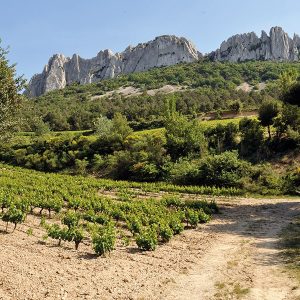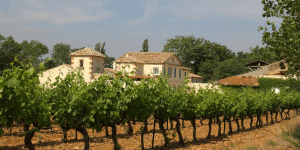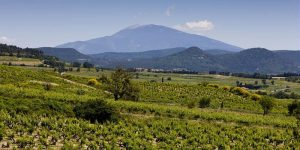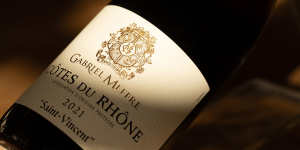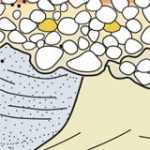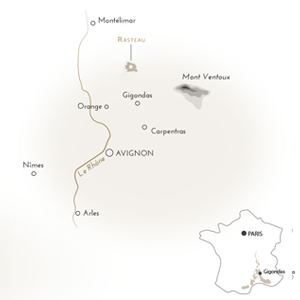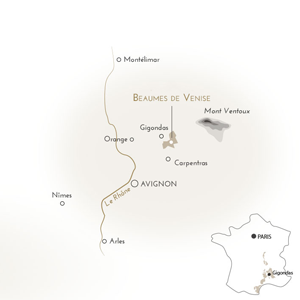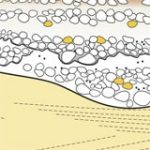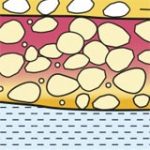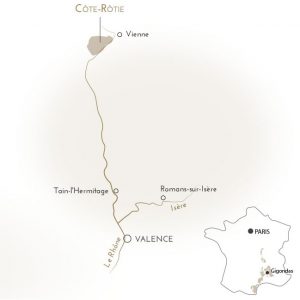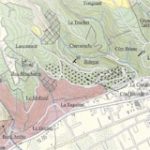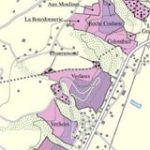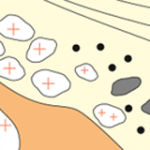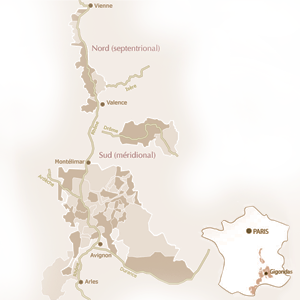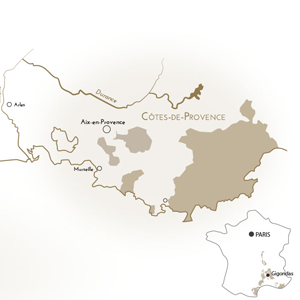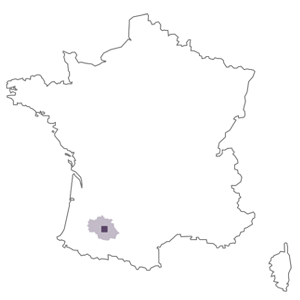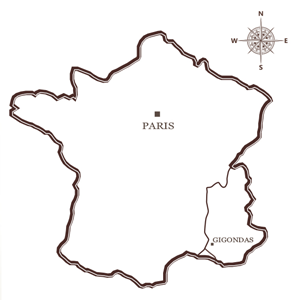Terroirs
“As a combination of a soil, a climate and a human expertise, the “terroir” is an essential notion on our estates and in the work we do with our wine-grower partners.
Learn about the terroirs of each appellation with these maps and geological cross-sections.”

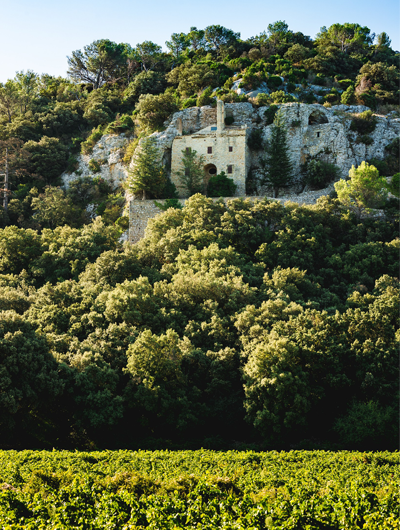
Lirac
The Cru Lirac vineyards are planted on terraces and hillsides in four communes on the right bank of the Rhône, between garrigue, mistral and arid soils bathed in bright sunshine. It is growing, preserved and tranquil, off the beaten track. Blending wines from different terroirs produces the Lirac style: powerful, structured and aromatic, yet fresh and always elegant.
The maps
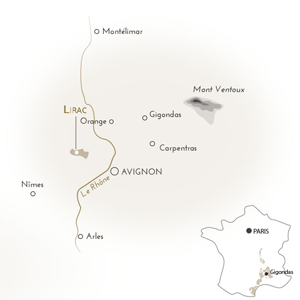
Geology
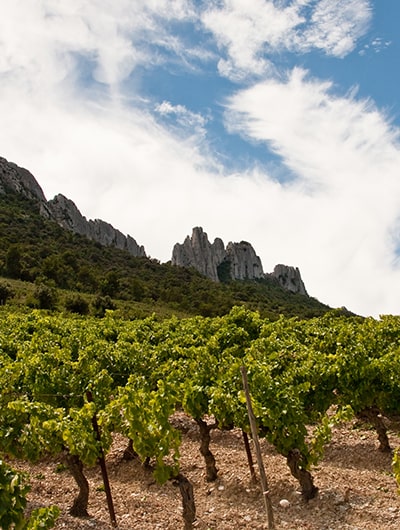
AOP Gigondas
The appellation is a mosaic of terroirs which draws its originality from the geological layers, altitude and particular orientation. Our plots are situated on 4 of the 5 terroirs which make up the appellation.
The maps
Geology
The grape varieties
Bourboulenc, Cinsault, Clairette, Grenache blanc, Grenache noir, Marsanne, Mourvèdre, Muscat à petits grains, Roussanne, Syrah & Viognier
See all grape varietiesOur wines
- Domaine de Longue Toque Gigondas 2018 Red
- Domaine de Longue Toque Gigondas 2017 Red
- Domaine de Longue Toque Gigondas 2016 Red
- Domaine de Longue Toque Gigondas 2014 Red
- Domaine de Longue Toque Gigondas 2013 Red
- Domaine de Longue Toque Gigondas 2012 Red
- Domaine de Longue Toque Gigondas 2011 Red
- Domaine de Longue Toque Gigondas 2010 Red
- Domaine de Longue Toque Gigondas - Organic 2020 Red
- Domaine de Longue Toque Gigondas Hommage à Gabriel Meffre 2017 Red
- Domaine de Longue Toque Gigondas Hommage à Gabriel Meffre 2016 Red
- Domaine de Longue Toque Gigondas Hommage à Gabriel Meffre 2015 Red
- Domaine de Longue Toque Gigondas Hommage à Gabriel Meffre 2013 Red
- Domaine de Longue Toque Gigondas Hommage à Gabriel Meffre 2010 Red
- Domaine de Longue Toque Gigondas Hommage à Gabriel Meffre 2003 Red
- Domaine de Longue Toque Gigondas Les Platrières 2018 Red
- Domaine de Longue Toque Gigondas Organic - Lieu-Dit 'Les Trois Yeux' 2020 Red
- Domaine de Longue Toque Gigondas Trois Yeux 2018 Red
- Domaine de Longue Toque Gigondas Trois Yeux 2017 Red
- Gabriel Meffre Gigondas "Sainte-Catherine" 2022 Red
- Gabriel Meffre Gigondas Sainte Catherine 2018 Red
- Gabriel Meffre Gigondas Sainte Catherine 2017 Red
- Gabriel Meffre Gigondas Sainte Catherine 2014 Red
- Gabriel Meffre Gigondas Sainte Catherine 2013 Red
- Gabriel Meffre Gigondas Sainte Catherine 2012 Red
- Gabriel Meffre Gigondas Sainte-Catherine 2021 Red
- Gabriel Meffre Gigondas Sainte-Catherine 2020 Red
- Gabriel Meffre Gigondas Sainte-Catherine 2019 Red
- Gabriel Meffre “Collection 1936” Gigondas DOMUS 2021 Red
- Laurus Gigondas 2019 Red
- Laurus Gigondas 2017 Red
- Laurus Gigondas 2016 Red
- Laurus Gigondas 2015 Red
- Laurus Gigondas 2014 Red
- Laurus Gigondas 2013 Red
- Laurus Gigondas 2012 Red
- Laurus Gigondas 2011 Red
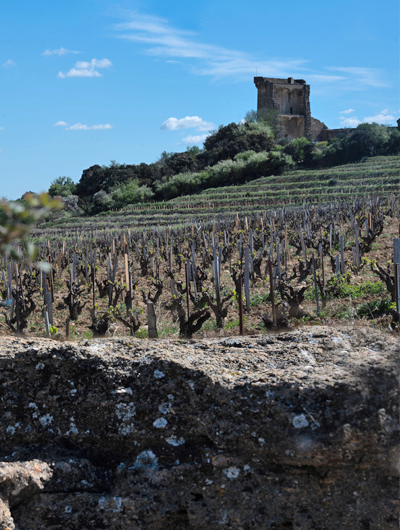
AOP Châteauneuf-Du-Pape
The Châteauneuf-du-Pape appellation is the jewel in the crown of the southern Rhône Valley's winegrowing heritage, and one of France's finest crus. In the 14th century, Pope Jean XXII built a fortress at Châteauneuf and developed the famous vineyard, whose cultivation is perpetuated in the great papal tradition of the City of the Popes in Avignon. This exceptional terroir, located on the left bank of the Rhône between Avignon and Orange, is made up of vast terraces covered with red clay mixed with numerous quartz pebbles. In the heart of the southern sector, the Mediterranean microclimate is the warmest in the Côtes-du-Rhône, with 2800 h of sunshine and an average temperature of 14°C over the year. Châteauneuf-du-Pape also owes its rich aromas to the use of a large number of grape varieties, 13 in all.
The maps
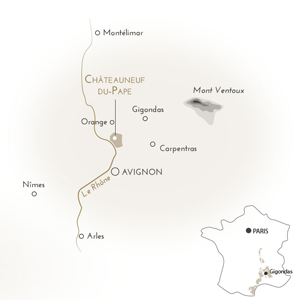
Geology
Our wines
- Gabriel Meffre Châteauneuf du Pape Saint-Theodoric 2011 Red
- Gabriel Meffre Châteauneuf-Du-Pape Saint Theodoric 2020 Red
- Gabriel Meffre Châteauneuf-Du-Pape Saint Theodoric 2019 Red
- Gabriel Meffre Châteauneuf-Du-Pape Saint Theodoric 2018 Red
- Gabriel Meffre Châteauneuf-Du-Pape Saint Theodoric 2017 Red
- Gabriel Meffre Châteauneuf-Du-Pape Saint Theodoric 2016 Red
- Gabriel Meffre Châteauneuf-Du-Pape Saint Theodoric 2015 Red
- Gabriel Meffre Châteauneuf-Du-Pape Saint Theodoric 2014 Red
- Gabriel Meffre Châteauneuf-Du-Pape Saint Theodoric 2013 Red
- Gabriel Meffre Châteauneuf-Du-Pape Saint Theodoric 2012 Red
- Gabriel Meffre Châteauneuf-Du-Pape Saint-Théodoric 2021 Red
- Laurus Châteauneuf-Du-Pape 2016 Red
- Laurus Châteauneuf-Du-Pape 2015 Red
- Laurus Châteauneuf-Du-Pape 2013 Red
- Laurus Châteauneuf-Du-Pape 2012 Red
- Laurus Châteauneuf-Du-Pape 2012 Red
- Laurus Châteauneuf-Du-Pape 2011 Red
- Laurus Châteauneuf-Du-Pape 2010 Red
- Laurus Châteauneuf-Du-Pape 2019 White
- Laurus Châteauneuf-Du-Pape 2018 White
- Laurus Châteauneuf-Du-Pape 2016 White
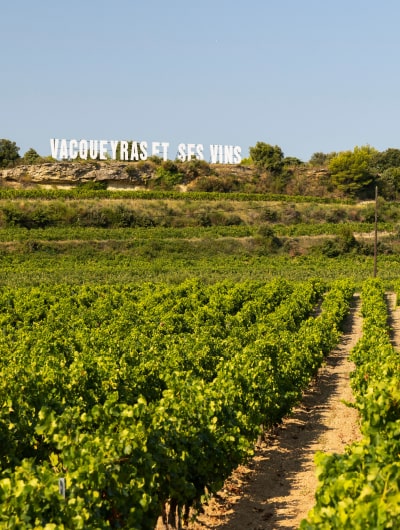
AOP Vacqueyras
Our plots are divided between the alluvial terrace of the Garrigues (scrubland) dating back to the quaternary period to the west and the safre (sandy rock) and marl from the tertiary period close to the village.
The maps
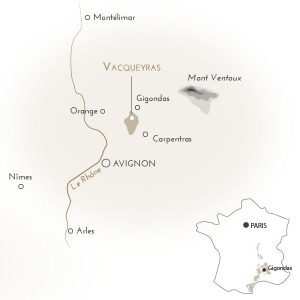
Geology
The grape varieties
Bourboulenc, Carignan, Cinsault, Clairette, Grenache blanc, Grenache noir, Marsanne, Mourvèdre, Roussanne, Syrah & Viognier
See all grape varietiesOur wines
- Domaine de Longue Toque Lieu-dit 'Les Ramières' - Organic 2021 Red
- Domaine de Longue Toque Vacqueyras 2019 Red
- Domaine de Longue Toque Vacqueyras 2018 Red
- Domaine de Longue Toque Vacqueyras 2017 Red
- Domaine de Longue Toque Vacqueyras 2015 Red
- Domaine de Longue Toque Vacqueyras 2014 Red
- Domaine de Longue Toque Vacqueyras 2013 Red
- Domaine de Longue Toque Vacqueyras 2012 Red
- Gabriel Meffre Saint Barthélémy 2022 Red
- Gabriel Meffre Vacqueyras "Saint-Barthélémy" 2021 Red
- Gabriel Meffre Vacqueyras Saint Barthelemy 2019 Red
- Gabriel Meffre Vacqueyras Saint Barthelemy 2018 Red
- Gabriel Meffre Vacqueyras Saint Barthelemy 2017 Red
- Gabriel Meffre Vacqueyras Saint Barthelemy 2016 Red
- Gabriel Meffre Vacqueyras Saint Barthelemy 2015 Red
- Gabriel Meffre Vacqueyras Saint Barthelemy 2014 Red
- Gabriel Meffre Vacqueyras Saint Barthelemy 2013 Red
- Gabriel Meffre Vacqueyras Saint Barthelemy 2012 Red
- Gabriel Meffre Vacqueyras Saint-Barthélémy 2020 Red
- Laurus Vacqueyras 2018 Red
- Laurus Vacqueyras 2017 Red
- Laurus Vacqueyras 2016 Red
- Laurus Vacqueyras 2015 Red
- Laurus Vacqueyras 2014 Red
- Laurus Vacqueyras 2011 Red

AOP Lirac
The Lirac Cru vineyards are planted on terraces and hillsides in four communes on the right bank of the Rhône, between garrigue, mistral and arid soils bathed in bright sunshine. It is growing, preserved and peaceful, off the beaten track. Blending wines from different terroirs produces the Lirac style: powerful, structured and aromatic, yet fresh and always elegant.
The maps

Geology
Our wines
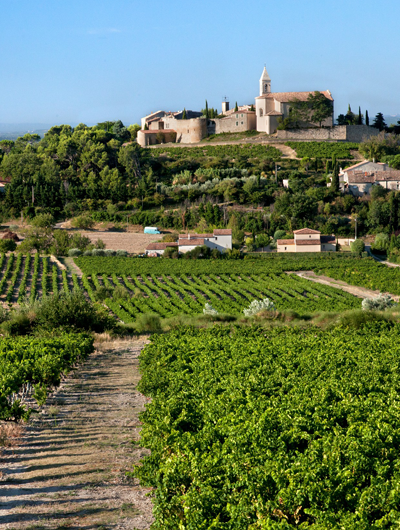
AOP Cairanne
Sun-drenched hillsides, fragrant garrigue, a mischievous river that changes its spelling... Cairanne is a charming village, unveiling itself at the bend of a rocky outcrop and enticing visitors with its red and white wines. The assets of the appellation: a "village" spirit nurtured by generations of winegrowers who have made their wine and their trade a craft for excellence.
The maps
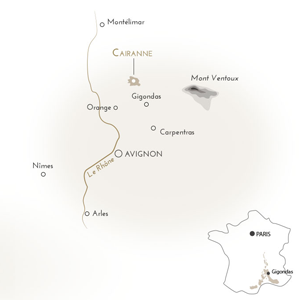
Geology
Our wines
- Domaine de Longue Toque CAIRANNE 2020 Red
- Domaine de Longue Toque Cairanne 2019 Red
- Gabriel Meffre Cairanne Saint Jean 2020 Red
- Gabriel Meffre Cairanne Saint Jean 2019 Red
- Gabriel Meffre Cairanne Saint Jean 2018 Red
- Gabriel Meffre Cairanne Saint Jean 2017 Red
- Gabriel Meffre Cairanne Saint-Jean 2023 Red
- Gabriel Meffre Cairanne Saint-Jean - Bio 2021 Red
- Gabriel Meffre Cairanne Saint Jean 2018 White
- Gabriel Meffre Cairanne Saint Jean 2016 White
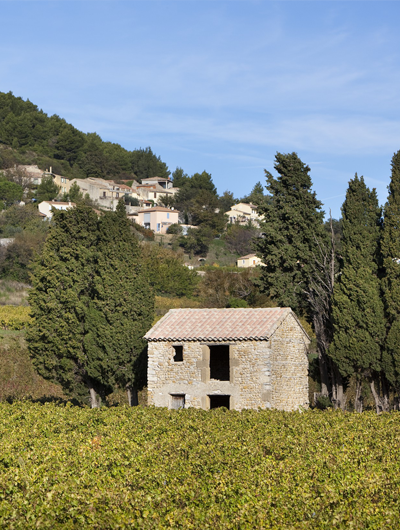
AOP Rasteau
Facing due south, this Haut-Vaucluse village perched on a 200-meter high hill faces the Dentelles de Montmirail. The vineyards, relatively sheltered from the Mistral wind, are planted on a wide variety of soils with very uneven relief, enabling the production of dry red wines with strong typicity.
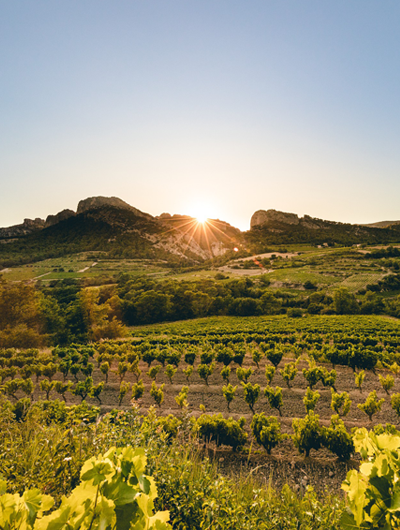
AOP Beaumes de Venise
The fertile vineyards that give birth to Beaumes-de-Venise wines borrow their landscapes from Tuscany... Vines and olive trees stand side by side on a land preserved by winemakers who combine sustainable agriculture with a love of an unusual, rich and precious terroir. The name "de Venise", though rich in romantic evocations, owes nothing to the city... It's a deformation of "de Venisse", meaning "du Comtat Venaissin". Situated at the foot of the Dentelles de Montmirail, the terroir is made up of three types of soil, most notably "Trias", the exceptional soil that enables the cultivation of a specific wine.
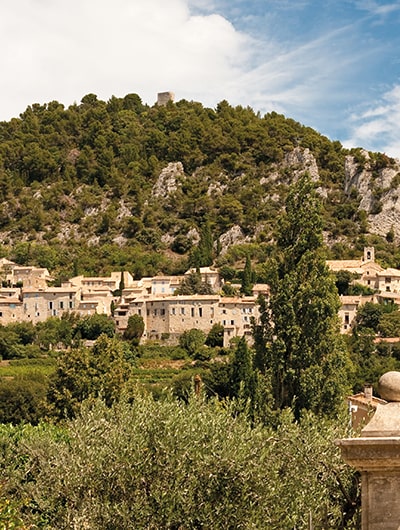
AOP Côtes du Rhône Villages Plan de Dieu
This is a wide, uniform terroir made of alluviums deposited by the Aygues and the Ouvèze in the quaternary period and covered in limestone gravel. Good hydration of the vines is provided by a deep blue clay soil and sandstone.
The maps
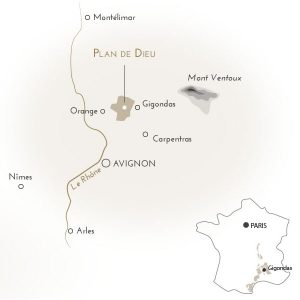
Geology
The grape varieties
Bourboulenc, Carignan, Cinsault, Clairette, Grenache blanc, Grenache noir, Marsanne, Mourvèdre, Roussanne, Syrah & Viognier
See all grape varietiesOur wines
- Domaine de Longue Toque Côtes du Rhône Villages Plan de Dieu 2019 Red
- Domaine de Longue Toque Côtes du Rhône Villages Plan de Dieu 2018 Red
- Domaine de Longue Toque Côtes du Rhône Villages Plan de Dieu 2017 Red
- Domaine de Longue Toque Côtes du Rhône Villages Plan de Dieu 2015 Red
- Domaine de Longue Toque Côtes du Rhône Villages Plan de Dieu 2014 Red
- Domaine de Longue Toque Côtes du Rhône Villages Plan de Dieu 2013 Red
- Domaine de Longue Toque Côtes du Rhône Villages Plan de Dieu 2012 Red
- Domaine de Longue Toque Côtes-du-Rhône Villages Plan de Dieu 2020 Red
- Domaine de Longue Toque Côtes-du-Rhône Villages Plan de Dieu - Organic 2022 Red
- Domaine de Longue Toque Côtes-du-Rhône Villages Plan de Dieu - Organic 2021 Red
- Gabriel Meffre Côtes du Rhône Villages Plan de Dieu "Saint Mapalis" 2021 Red
- Gabriel Meffre Côtes du Rhône Villages Plan de Dieu Saint Mapalis 2022 Red
- Gabriel Meffre Côtes du Rhône Villages Plan de Dieu Saint Mapalis 2020 Red
- Gabriel Meffre Côtes du Rhône Villages Plan de Dieu Saint Mapalis 2019 Red
- Gabriel Meffre Côtes du Rhône Villages Plan de Dieu Saint Mapalis 2018 Red
- Gabriel Meffre Côtes du Rhône Villages Plan de Dieu Saint Mapalis 2017 Red
- Gabriel Meffre Côtes du Rhône Villages Plan de Dieu Saint Mapalis 2016 Red
- Gabriel Meffre Côtes du Rhône Villages Plan de Dieu Saint Mapalis 2014 Red

AOP Côtes du Rhône Villages
In its southern part, the Côtes du Rhône Villages vineyards stretch over the terraces and alluvial plains of the Rhône, or over the slopes of various hills, at the top of which nest as many perched villages. Vines have been grown here since Roman times, and no fewer than 95 communes make up the Côtes du Rhône Villages vineyards. From the Drôme Provençale to the banks of the Durance in the east, and from the Ardèche to the Pont du Gard in the west, discover these villages perched on their promontories to unearth the finest nuggets. Depending on the nature of the soil, you'll come across a wide range of Côtes du Rhône Villages, but one thing's for sure: you'll need more than a day to tour them all!
The maps
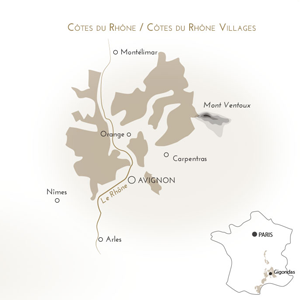
Geology
Our wines
- Gabriel Meffre Côtes du Rhône Villages 2020 Red
- Gabriel Meffre Côtes du Rhône Villages 2017 Red
- Gabriel Meffre Côtes du Rhône Villages 2016 Red
- Gabriel Meffre Côtes du Rhône Villages Saint Siffrein 2017 Red
- Gabriel Meffre Côtes du Rhône Villages Saint Siffret 2022 Red
- Gabriel Meffre Côtes du Rhône Villages St Siffret 2018 Red
- Laurus Côtes du Rhône Villages 2021 Red
- Laurus Côtes du Rhône Villages 2018 Red
- Laurus Côtes du Rhône Villages 2017 Red
- Laurus Côtes du Rhône Villages 2016 Red
- Laurus Côtes du Rhône Villages 2015 Red
- Laurus Côtes du Rhône Villages 2014 Red
- Laurus Côtes du Rhône Villages 2013 Red
- Laurus Côtes du Rhône Villages 2012 Red
- Laurus Côtes du Rhône Villages 2011 Red
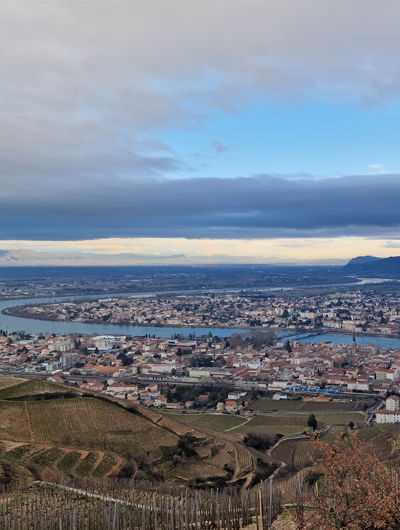
AOP Côtes du Rhône
Along the Rhône, the vineyards of the Côtes du Rhône appellation are spread over 171 communes and richly varied terroirs... all under the same generous sun. Take the time to explore them: they all surprise you with their diversity and the strength of their character. Among them, you'll discover nuggets that are often unsuspected.
The maps

Geology
Our wines
- Domaine de Longue Toque Côtes du Rhône 2020 Red
- Domaine de Longue Toque Côtes du Rhône 2019 Red
- Domaine de Longue Toque Côtes du Rhône red 2021 Red
- Gabriel Meffre Côtes du Rhône Saint François 2019 Red
- Gabriel Meffre Côtes du Rhône Saint François 2016 Red
- Gabriel Meffre Côtes du Rhône Saint François 2016 Red
- Gabriel Meffre Côtes du Rhône Saint François 2015 Red
- Gabriel Meffre Côtes du Rhône Saint Vincent 2021 Red
- Gabriel Meffre Côtes du Rhône Saint Vincent 2020 Red
- Gabriel Meffre Côtes du Rhône Saint Vincent 2020 Red
- Gabriel Meffre Côtes du Rhône Saint Vincent 2020 Red
- Gabriel Meffre Côtes du Rhône Saint Vincent 2018 Red
- Gabriel Meffre Côtes du Rhône Saint Vincent 2017 Red
- Gabriel Meffre Côtes du Rhône Saint Vincent 2014 Red
- Gabriel Meffre Côtes du Rhône Saint-François - Bio 2021 Red
- Gabriel Meffre Côtes du Rhône Saint-Vincent 2018 Red
- Gabriel Meffre Saint Vincent 2022 Red
- Gabriel Meffre “Collection 1936” Côtes du Rhône 2021 Red
- Gabriel Meffre “Collection 1936” Côtes du Rhône Organic Terra 2022 Red
- Gabriel Meffre “Collection 1936” Côtes du Rhône Organic Terra 2021 Red
- Domaine de Longue Toque Côtes du Rhône 2020 White
- Domaine de Longue Toque Côtes du Rhône 2019 White
- Domaine de Longue Toque Côtes du Rhône 2018 White
- Domaine de Longue Toque Côtes du Rhône 2017 White
- Domaine de Longue Toque Côtes du Rhône white Organic 2022 White
- Domaine de Longue Toque Côtes du Rhône white Organic 2021 White
- Gabriel Meffre Côtes du Rhône Saint François 2021 White
- Gabriel Meffre Côtes du Rhône Saint Vincent 2022 White
- Gabriel Meffre Côtes du Rhône Saint Vincent 2021 White
- Gabriel Meffre Côtes du Rhône Saint Vincent 2020 White
- Gabriel Meffre Côtes du Rhône Saint Vincent 2019 White
- Gabriel Meffre Côtes du Rhône Saint Vincent 2018 White
- Gabriel Meffre Côtes du Rhône Saint Vincent 2018 White
- Gabriel Meffre Côtes du Rhône Saint Vincent 2017 White
- Gabriel Meffre Côtes du Rhône Saint Vincent 2017 White
- Gabriel Meffre Côtes du Rhône Saint Vincent 2016 White
- Gabriel Meffre Côtes du Rhône Saint Vincent 2016 White
- Gabriel Meffre “Collection 1936” Côtes du Rhône 2021 White
- Gabriel Meffre “Collection 1936” Côtes du Rhône Organic Terra 2022 White
- Laurus Côtes du Rhône 2022 White
- Laurus Côtes du Rhône 2021 White
- Laurus Côtes du Rhône 2020 White
- Laurus Côtes du Rhône 2019 White
- Laurus Côtes du Rhône 2018 White
- Laurus Côtes du Rhône 2017 White
- Laurus Côtes du Rhône 2016 White
- Laurus Côtes du Rhône 2015 White
- Laurus Côtes du Rhône 2014 White
- Laurus Côtes du Rhône 2013 White
- Gabriel Meffre Côtes du Rhône "Saint Vincent" 2023 Rosé
- Gabriel Meffre Côtes du Rhône "Saint Vincent" 2022 Rosé
- Gabriel Meffre Côtes du Rhône Saint Vincent 2021 Rosé
- Gabriel Meffre Côtes du Rhône Saint Vincent 2020 Rosé
- Gabriel Meffre Côtes du Rhône Saint Vincent 2019 Rosé
- Gabriel Meffre Côtes du Rhône Saint Vincent 2018 Rosé
- Gabriel Meffre Côtes du Rhône Saint Vincent 2017 Rosé
- Gabriel Meffre Côtes du Rhône Saint Vincent 2016 Rosé
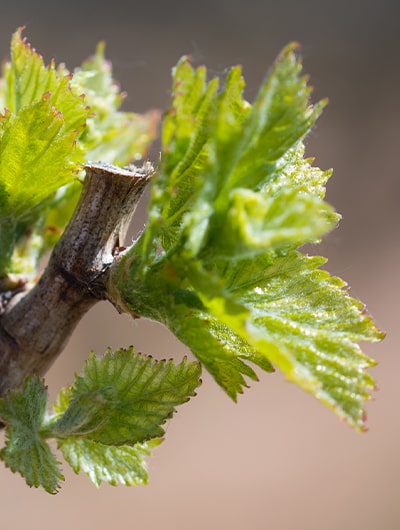
AOP Costières de Nîmes
The Costières terroir is made of gravel deposited by the Rhône and the Durance in the quaternary period, covered in different coloured sands on a deep blue clay soil. The vines of Château Grand Escalion come from a contiguous geographical area.
The maps
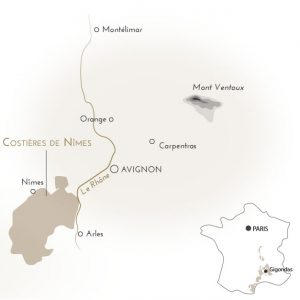
Geology
The grape varieties
Bourboulenc, Carignan, Cinsault, Clairette, Grenache blanc, Grenache noir, Marsanne, Mourvèdre, Roussanne, Syrah & Viognier
See all grape varietiesOur wines
- Château Grand Escalion Costières de Nîmes Safranee 2021 Red
- Château Grand Escalion Costières de Nîmes Safranee 2020 Red
- Château Grand Escalion Costières de Nîmes Safranee 2019 Red
- Château Grand Escalion Costières de Nîmes Safranee 2018 Red
- Château Grand Escalion Costières de Nîmes Safranee 2017 Red
- Château Grand Escalion Costières de Nîmes Safranee 2016 Red
- Château Grand Escalion Costières de Nîmes Safranee 2015 Red
- Château Grand Escalion Costières de Nîmes Safranee 2014 Red
- Château Grand Escalion Costières de Nîmes Safranée 2022 Red
- Château Grand Escalion Costières de Nîmes Safranée 2019 Red
- Gabriel Meffre Costières de Nîmes 2018 Red
- Château Grand Escalion Costières de Nîmes Romane 2023 White
- Château Grand Escalion Costières de Nîmes Romane 2022 White
- Château Grand Escalion Costières de Nîmes Romane 2021 White
- Château Grand Escalion Costières de Nîmes Romane 2020 White
- Château Grand Escalion Costières de Nîmes Romane 2019 White
- Château Grand Escalion Costières de Nîmes 2019 Rosé
- Château Grand Escalion Costières de Nîmes 2018 Rosé
- Château Grand Escalion Costières de Nîmes 2017 Rosé
- Château Grand Escalion Costières de Nîmes 2015 Rosé
- Château Grand Escalion Costières de Nîmes Amoureuse 2023 Rosé
- Château Grand Escalion Costières de Nîmes Amoureuse 2022 Rosé
- Château Grand Escalion Costières de Nîmes Amoureuse 2021 Rosé
- Château Grand Escalion Costières de Nîmes Amoureuse 2020 Rosé
- Château Grand Escalion Costières de Nîmes Amoureuse 2019 Rosé
- Château Grand Escalion Costières de Nîmes Amoureuse 2018 Rosé
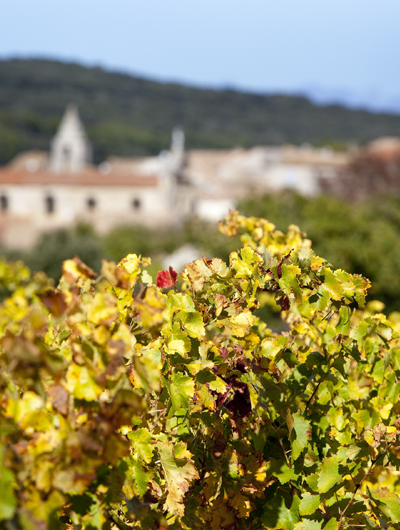
AOP Tavel
Tavel wines are all rosés... But what a rosé! The novelist Honoré de Balzac said that this is one of the rare rosés that can be advantageously left to age... Its wines of strong character are without equal: complex, fleshy, dense and highly aromatic.
The maps
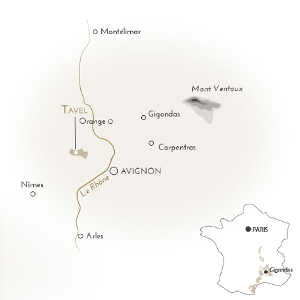
Geology
Our wines
- Gabriel Meffre Tavel 2020 Rosé
- Gabriel Meffre Tavel "Saint-Valentin" Bio 2022 Rosé
- Gabriel Meffre Tavel Saint Ferreol 2019 Rosé
- Gabriel Meffre Tavel Saint Ferreol 2018 Rosé
- Gabriel Meffre Tavel Saint Ferreol 2017 Rosé
- Gabriel Meffre Tavel Saint Ferreol 2016 Rosé
- Gabriel Meffre Tavel Saint Valentin Organic 2021 Rosé
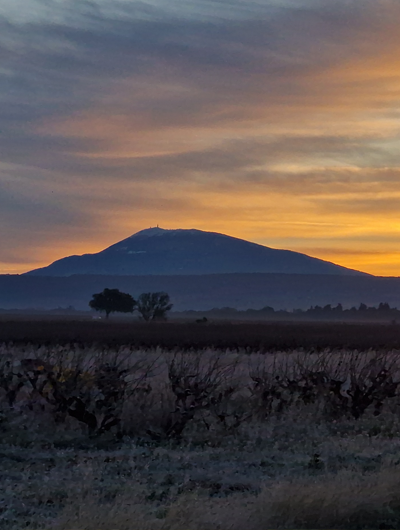
AOP Ventoux
Classified as a Biosphere Reserve by UNESCO in 1990, the Mont Ventoux site is a showcase for terroirs that have been cultivated with respect for nature and the region's cultural and historical heritage.
The maps
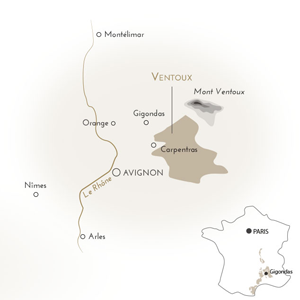
Geology
Our wines
- Gabriel Meffre Ventoux Saint Petrarque 2021 Red
- Gabriel Meffre Ventoux Saint Petrarque 2020 Red
- Gabriel Meffre Ventoux Saint Petrarque 2019 Red
- Gabriel Meffre Ventoux Saint Petrarque 2017 Red
- Gabriel Meffre Ventoux Saint Petrarque 2016 Red
- Gabriel Meffre Ventoux Saint Petrarque 2015 Red
- Gabriel Meffre Ventoux Saint Petrarque 2014 Red
- Gabriel Meffre Ventoux Saint Petrarque 2013 Red

VDN Muscat Beaumes de Venise
Northeast of Avignon, Châteauneuf-du-Pape, Vacqueyras and Gigondas set the Beaumes-de-Venise terroir against the backdrop of Mont Ventoux. The vineyards are located on the southeastern slopes of the Dentelles de Montmirail (between 100 and 600 m) in northern Vaucluse, where vines and olive trees harmoniously share the landscape. The deep, well-aired soils give Muscat its finesse, resulting in a naturally sweet wine of great elegance.
The maps
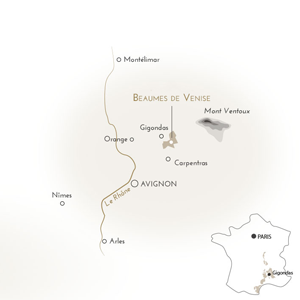
Geology
Our wines
- Gabriel Meffre Muscat Beaumes de Venise 2016 White
- Gabriel Meffre Muscat Beaumes de Venise 2015 White
- Laurus Muscat Beaumes de Venise 2022 White
- Laurus Muscat Beaumes de Venise 2020 White
- Laurus Muscat Beaumes de Venise 2019 White
- Laurus Muscat Beaumes de Venise 2018 White
- Laurus Muscat Beaumes de Venise 2017 White
- Laurus Muscat Beaumes de Venise 2016 White
- Laurus Muscat Beaumes de Venise 2015 White
- Laurus Muscat Beaumes de Venise 2014 White
- Laurus Muscat Beaumes de Venise 2013 White
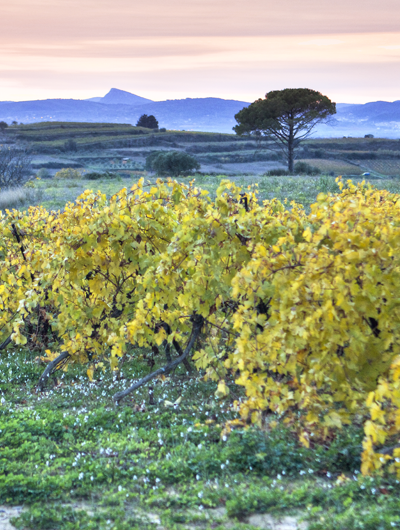
IGP Pays d'Oc
Since August 1, 2009, Pays d'Oc wines have benefited from an official sign of quality recognized at European level, the Indication Géographique Protégée (IGP). This is a 100% guarantee of the origin of wines produced under this name in the Pays d'Oc vineyards. Totally in tune with the times, Pays d'Oc PGI wines celebrate thirty years of conquest in the heart of France's oldest vineyard, founded in the 6th century BC.
The maps
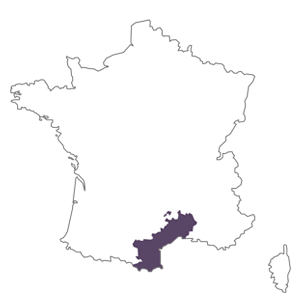
Geology
Our wines
- Fat Bastard Pays d'Oc Syrah 2021 Red
- Gabriel Pays d'Oc Cabernet-Sauvignon 2021 Red
- Gabriel Pays d'Oc Cabernet-Sauvignon 2020 Red
- Gabriel Pays d'Oc Merlot 2021 Red
- Laurus Pays d'Oc Syrah 2019 Red
- Laurus Pays d'Oc Syrah 2018 Red
- Laurus Pays d'Oc Syrah 2015 Red
- Laurus Pays d'Oc Syrah 2014 Red
- Laurus Pays d'Oc Syrah 2013 Red
- Fat Bastard Pays d'Oc Chardonnay 2021 White
- Gabriel Pays d'Oc Chardonnay 2022 White
- Gabriel Pays d'Oc Viognier 2021 White
- Laurus Pays d'Oc Viognier 2021 White
- Laurus Pays d'Oc Viognier 2020 White
- Laurus Pays d'Oc Viognier 2017 White
- Laurus Pays d'Oc Viognier 2016 White
- Laurus Pays d'Oc Viognier 2015 White
- Laurus Pays d'Oc Viognier 2014 White
- Laurus Pays d'Oc Viognier 2013 White
- Fat Bastard Pays d'Oc Grenache 2022 Rosé
- Gabriel Pays d'Oc Rosé 2021 Rosé

AOP Hermitage
Situated on a hill, the appellation consists of three parts: granite soil to the west, ideal for red wines; limestone and silica in the centre with a more fertile lower part to the east, famed for white wines.
The maps
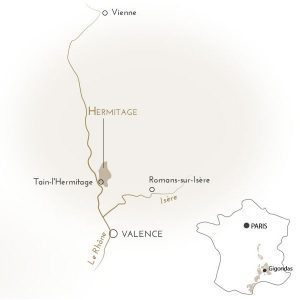
Geology
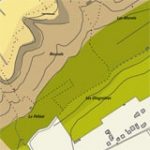
The grape varieties
Marsanne, Roussanne & Syrah
See all grape varietiesOur wines
- Laurus Hermitage 2020 Red
- Laurus Hermitage 2019 Red
- Laurus Hermitage 2018 Red
- Laurus Hermitage 2016 Red
- Laurus Hermitage 2015 Red
- Laurus Hermitage 2014 Red
- Laurus Hermitage 2013 Red
- Laurus Hermitage 2012 Red
- Laurus Hermitage 2011 Red
- Laurus Hermitage 2010 Red
- Laurus Hermitage 2019 White
- Laurus Hermitage 2018 White
- Laurus Hermitage 2017 White
- Laurus Hermitage 2016 White
- Laurus Hermitage 2013 White
- Laurus Hermitage 2012 White
- Laurus Hermitage 2011 White
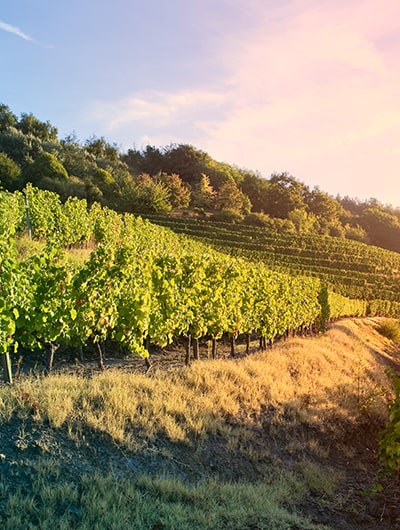
AOP Côte Rôtie
Known for its impressive slopes, which sometimes have a gradient of more than 60 degrees, AOP Côte Rôtie is situated on metamorphic rock. There are three types of soil: mica schist, gneiss and migmatite.

AOP Condrieu
The loamy alluviums of the Rhône cohabit here with the granite soils of the abrupt slopes where the vines are planted on "chayées" (narrow terraces) which are particularly difficult to work.
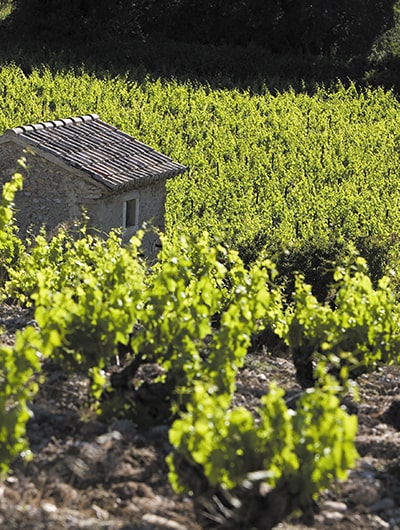
AOP Saint Joseph
Although granite reigns here, it shares the limelight with soft gneiss to the north and marl to the south. This diversity is what gives the appellation its typicality.
The maps
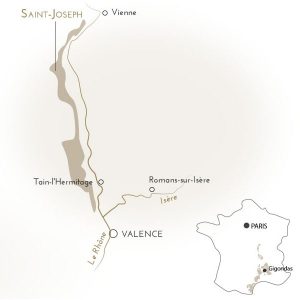
Geology
The grape varieties
Marsanne, Roussanne & Syrah
See all grape varietiesOur wines
- Gabriel Meffre Saint Joseph Saint Etienne 2021 Red
- Gabriel Meffre Saint Joseph Saint Etienne 2020 Red
- Gabriel Meffre Saint Joseph Saint Etienne 2019 Red
- Gabriel Meffre Saint Joseph Saint Etienne 2018 Red
- Gabriel Meffre Saint Joseph Saint Etienne 2017 Red
- Gabriel Meffre Saint Joseph Saint Etienne 2016 Red
- Gabriel Meffre Saint Joseph Saint Etienne 2015 Red
- Laurus Saint Joseph 2021 Red
- Laurus Saint Joseph 2020 Red
- Laurus Saint Joseph 2019 Red
- Laurus Saint Joseph 2016 Red
- Laurus Saint Joseph 2015 Red
- Laurus Saint Joseph 2014 Red
- Laurus Saint Joseph 2013 Red
- Laurus Saint Joseph 2012 Red
- Laurus Saint Joseph 2011 Red
- Gabriel Meffre Saint Joseph Saint Etienne 2019 White
- Gabriel Meffre Saint Joseph Saint Etienne 2018 White
- Gabriel Meffre Saint-Joseph "Saint-Etienne" 2022 White
- Gabriel Meffre Saint-Joseph "Saint-Etienne" 2020 White
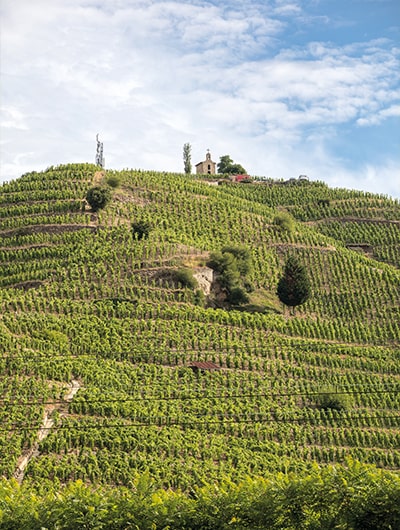
AOP Crozes-Hermitage
Covering over 1,500 ha, the vineyard flourishes on a variety of soils: gravel, red clay, loess, white sand and granite, each one adding its own characteristic to the grape variety.
The maps
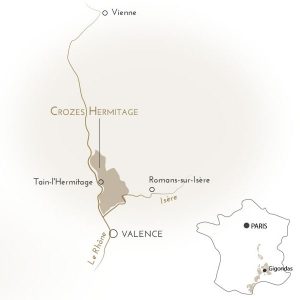
Geology
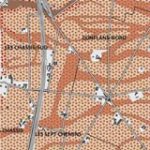
The grape varieties
Marsanne, Roussanne & Syrah
See all grape varietiesOur wines
- Gabriel Meffre Crozes-Hermitage Saint Pierre 2022 Red
- Gabriel Meffre Crozes-Hermitage Saint Pierre 2021 Red
- Gabriel Meffre Crozes-Hermitage Saint Pierre 2020 Red
- Gabriel Meffre Crozes-Hermitage Saint Pierre 2017 Red
- Gabriel Meffre Crozes-Hermitage Saint Pierre 2016 Red
- Gabriel Meffre Crozes-Hermitage Saint Pierre 2015 Red
- Laurus Crozes-Hermitage 2019 Red
- Laurus Crozes-Hermitage 2017 Red
- Laurus Crozes-Hermitage 2016 Red
- Laurus Crozes-Hermitage 2015 Red
- Laurus Crozes-Hermitage 2014 Red
- Laurus Crozes-Hermitage 2013 Red
- Laurus Crozes-Hermitage 2012 Red
- Laurus Crozes-Hermitage 2011 Red
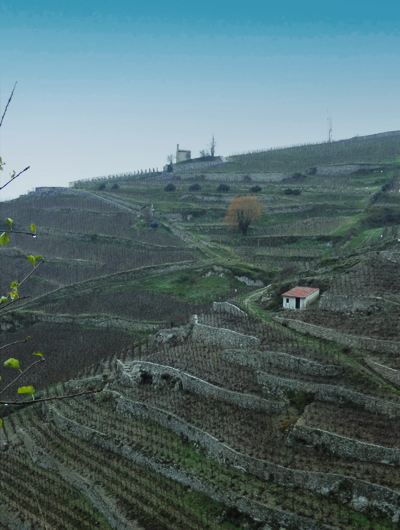
IGP Collines Rhodaniennes
The Collines Rhodaniennes cover the Rhône, Loire, Isère, Drôme and Ardèche regions: a rich mosaic that allows winemakers to give free rein to their creativity.
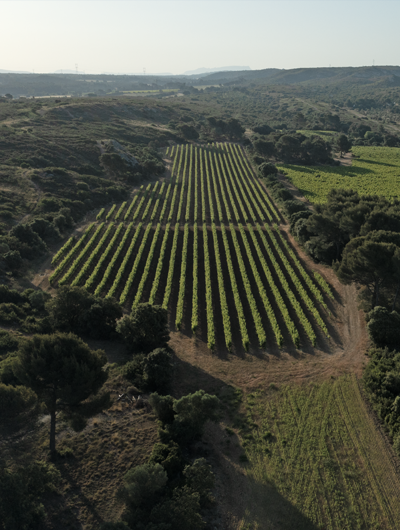
AOP Côtes de Provence
The Côtes de Provence appellation covers more than 20,000 hectares in 3 départements: Var, Bouches-du-Rhône and one commune in Alpes-Maritimes, a total of 84 communes. The terroir of the Côtes de Provence appellation is as beautiful in the vines as it is in the roots. The complex geology of the subsoil is particularly well-suited to wine.
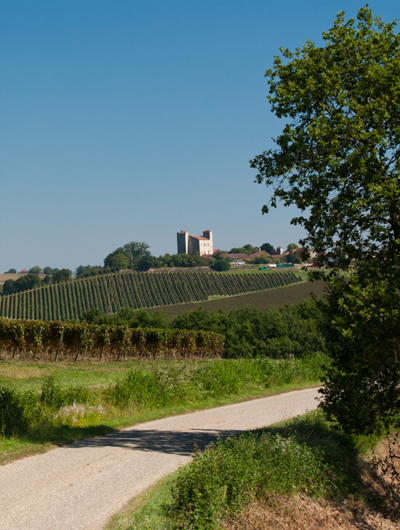
IGP Côtes de Gascogne
Since August 1, 2009, Côtes de Gascogne has been registered as a protected geographical indication. The production area is located in Gascony, the historic province of south-western France, between the Garonne river to the north, the Landes forest to the west and the Pyrenees to the south.
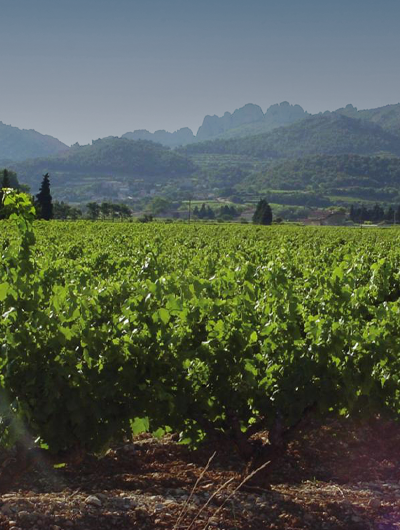
VDF Vin de France
Vin De France is a category of its own, with a unique DNA. If the name had to be summed up in one word, it would be "freedom". Its main advantage lies not in the zone of origin, nor in the principle of strict specifications, but in the creative freedom it offers the winemaker and the winegrower. Vin De France is thus a veritable "creative playground" for these true artists, who produce harmonious wines that are easy to enjoy.
